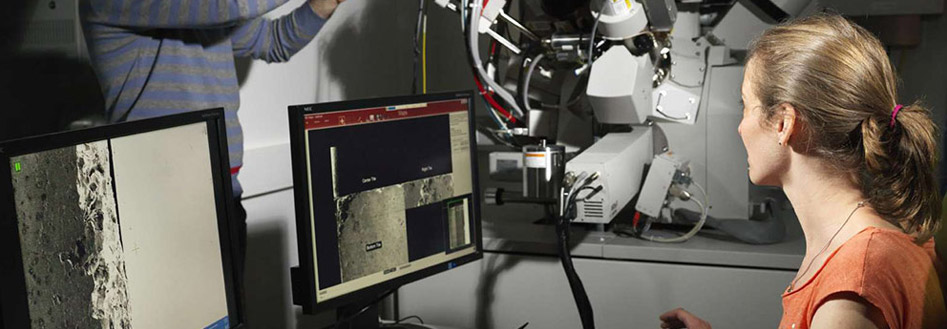
Mechanical behavior of structures, with scales widely varying from a kilometer (earthquake engineering) to a nanometer (composites reinforced by carbon nanotubes), based on a strong multidisciplinary approach with combined experience and supercomputing
The laboratory is organized as a matrix, with two permanent teams and three lines of research on current scientific subjects. The permanent teams combine complementary skills and methodologies based around Mechanics:
-
Mechanics, Physics and Biology for the MSE team
-
Mechanics and Applied Mathematics for the DSE team
The Materials Science and Engineering (MSE) team has a dozen researchers and instructor-researchers working in complementary fields related to metallic materials, geomaterials, reinforced polymers and biomaterials and biological tissues. Covering several scales, from nanometers to a massive macroscopic sample, the approaches used combine experience, modeling and simulation, in a constant dialogue.
The Digital Science and Engineering (DSE) team develops digital models and methods to simulate the mechanical behavior of materials and structures. Models developed range from the atomic scale, with ab initio finite elements used to determine the mechanical properties of a material, from a simplified resolution of the Schrödinger equation to the kilometric scale for seismic calculations used to identify site responses within cities.
Lines of Research
The lines of research bring together researchers from both teams with scientific objectives and/or fields of application that correspond to current scientific challenges:
- Approaches related to multiphysics, interactions between mechanics, physics and biology, interfaces, for the MPI line of research
- dynamics, waves, loads and random media for the DynOdAs [Dynamics, Waves and Hazards] line of research
- Multi-scale approaches to the mechanics of materials and structures for the CM3 line of research
The application fields in this research relate to energy (nuclear), transportation (aeronautic, railway, automobile), civil engineering (soil, seismic), and health (biomechanical prostheses, tissue bioengineering).
Key Figures
-
Instructor-researchers and researchers: 19
-
Visitors and post-docs: 8
-
Technical and administrative staff: 18
-
PhD students: 39
-
Tier A publications (Source: Web of Science): 34
-
Value of signed contracts: €1,045,875 (excluding chairs)
Academic Partners
Numerous French universities and CNRS, CEA laboratories, etc.
Abroad:
- Technische Universität Wien (Austria)
- Université de Louvain and Université Libre de Bruxelles (Belgium)
- Universidade Federal do Rio de Janeiro (Brazil)
- École Polytechnique de Montréal and University of British Columbia (Canada)
- Institute of Metal Research Shenyang/Chinese Academy of Science, Institute of Physics/Chinese Academy of Sciences, Northwest University, Beijing University of Science and Technology and Beijing University of Aeronautics and Astronautics (China)
- Universidad de los Andes (Colombia)
- Czech Technical University in Prague (Czech Republic)
- Aristotle University of Thessaloniki (Greece)
- Università Mediterranea di Reggio Calabria (Italy)
- Saitama University (Japan)
- Instituto Superior Técnico (Universidade de Lisboa) and Universidade do Minho (Portugal)
- Perm State Pedagogical University (Russia)
- BarcelonaTech (Spain)
- Tishreen University in Latakia (Syria)
- Faculty of Sciences of Bizerta (Tunisia)
- Institute for Computational Engineering and Science (University of Texas at Austin)
- Ames Lab (Iowa State University, IA), University of Illinois (Urbana-Champaign, IL), Jet Propulsion Laboratory (NASA-Caltech, Pasadena, CA) and Columbia University (New York, NY) (U.S.A.)
- Universidad Central de Venezuela (Venezuela)
Industrial Partners
ArcelorMittal, Areva, Aubert & Duval, Bouyer Leroux, CEA, CNES, EADS, EDF, Gecko Biomedical, IFTH, INERIS, ITER, Lhoist, Michelin, NECS, Nexans, Orona, Schlumberger, SNCF, Safran Aircraft Engines, Thales
Collaborations and Partnerships
Fields of Application
Natural and anthropogenic risks, transportation (space, aeronautics, railway, automobile), energy (oil, nuclear facility security: damage, corrosion, fatigue), nanomaterials, health biomechanics and engineering
Specific Equipment
Access to the SGI Altix ICE 8400 LX and UV100 computer at the CentraleSupélec Scientific Computing Center
Software developed in the laboratory
Mechanical testing Resource Center
- High-temperature hydraulic testing machine
- Nanoindenter
- X-ray diffractometer
- Electromechanical testing machines
- Wire torsion testing machine
Microscopy Resource Center
CONTACT
Website: www.mssmat.ecp.fr
Director: Damien Durville
Tel.: +33 (0)1 41 13 12 90
Fax: +33 (0)1 41 13 13 42
E-mail: nathalie.langlet@ecp.fr

